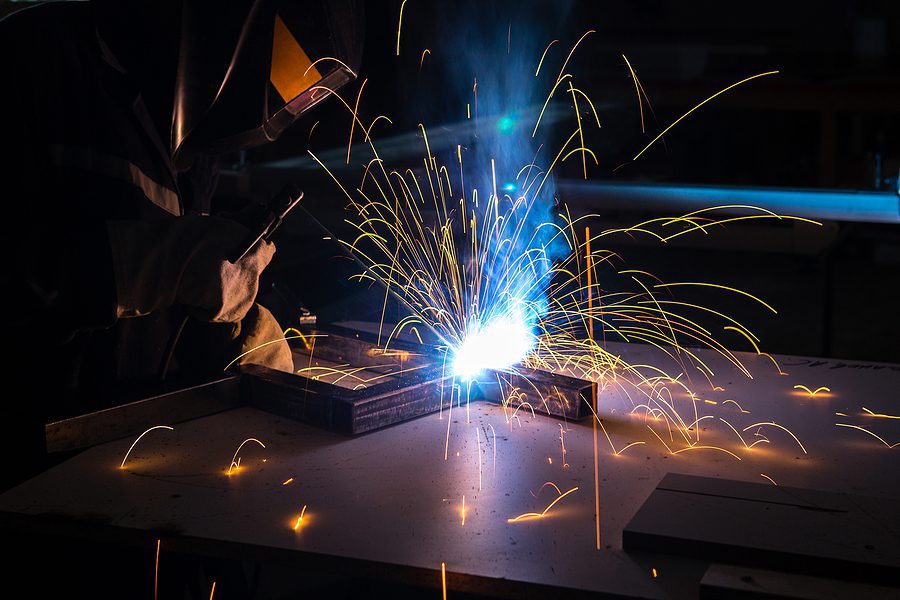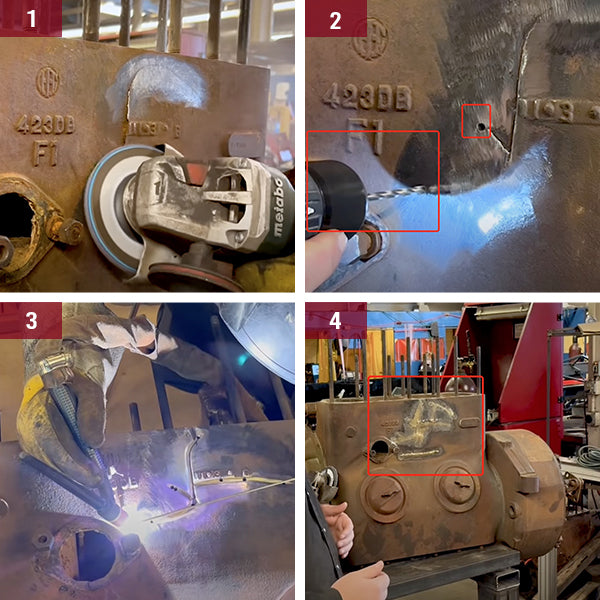Typical Welding Fixing Issues and Just How to Address Them Properly
Welding repair work typically encounter a variety of concerns that can jeopardize the honesty of the final item. Common problems include inadequate penetration, porosity, and imbalance, to name a few. Each flaw offers one-of-a-kind challenges that require certain strategies for resolution. Recognizing these issues is essential for welders aiming to boost their skills and results. This discussion will certainly explore these typical welding repair work problems and reliable methods to address them.
Inadequate Infiltration
Inadequate infiltration takes place when the weld metal falls short to totally fuse with the base product, resulting in weak joints and potential structural failures. This problem commonly stems from inadequate heat input, inaccurate electrode angle, or incorrect welding rate. Welders might encounter insufficient infiltration because of a mistake of the necessary specifications for a certain material density or kind. Additionally, contamination on the base material's surface can hinder reliable bonding, intensifying the problem. To attend to poor penetration, welders need to guarantee appropriate settings on their tools and maintain a tidy work surface area. Routine evaluation of welds is recommended to identify any shortages early, permitting timely improvements and the prevention of compromised structural integrity in bonded settings up.
Porosity
Porosity is a common problem in bonded joints that manifests as small gas bubbles caught within the weld steel. This problem can endanger the honesty of the weld, resulting in reduced strength and possible failure under stress and anxiety. Belgrade Fabrication. Porosity typically arises from contamination, moisture, or inappropriate welding methods, which enable gases to get away right into the liquified weld swimming pool. To attend to porosity, welders should guarantee proper surface preparation, preserve a clean functioning atmosphere, and utilize suitable welding specifications. Furthermore, selecting the ideal filler product and securing gas can minimize gas entrapment. Regular examination and screening of welds can help recognize porosity early, guaranteeing timely rehabilitative activities are taken, therefore protecting the quality and reliability of the bonded structure
Imbalance
Imbalance in welding can arise from various elements, including incorrect configuration and thermal development. Comprehending the source is important for reliable resolution. Several modification techniques are readily available to straighten components and guarantee structural stability.
Sources of Misalignment
Welding imbalance commonly comes from a variety of underlying problems that can endanger structural stability. One key cause is inappropriate fit-up of parts prior to welding, which can result in voids and unequal surfaces. Variations in thermal expansion during the welding procedure can also result in distortion, particularly if the materials being signed up with have different coefficients of expansion. Additionally, poor fixturing and clamping may fail to hold parts safely in position, leading to motion during welding. Poorly kept equipment, including welding devices and devices, may present incongruities in the weld grain, further adding to misalignment. Operator mistake, stemming from inadequate training or experience, can likewise play a significant role in producing misaligned welds.

Correction Methods Offered
Resolving misalignment properly needs a combination of rehabilitative techniques tailored to the particular problems at hand. One common approach is the usage of jigs or components to hold elements in the right position during welding, ensuring constant positioning. Additionally, preheating the products can help in reducing distortion and improve fit-up. For considerable imbalance, mechanical adjustment techniques, such as utilizing hydraulic jacks or clamps, can be used to deal with the placement before welding. Post-weld warm therapy may likewise be necessary to relieve anxieties brought on by misalignment. Ultimately, mindful assessment and modification during the setup stage can prevent misalignment concerns from becoming considerable problems, promoting a smoother welding procedure and improving total architectural honesty.
Distortion
Distortion is a common obstacle in welding that can occur from various elements, consisting of irregular cooling and heating. Understanding the root causes of distortion is necessary for applying reliable avoidance methods. Addressing this issue not just boosts structural honesty however also enhances the total quality of the weld.
Sources of Distortion
When subjected to the extreme warmth of welding, products usually undertake changes that can result in distortion. This phenomenon mostly develops from thermal growth and tightening throughout the welding procedure. As the weld location warms up, the material increases; upon cooling, it acquires, which can develop inner tensions. Additionally, unequal heating across a work surface can aggravate these anxieties, resulting in warping or flexing. The kind of product also plays a significant function; steels with varying thermal conductivity and coefficients of expansion may respond in different ways, causing unforeseeable distortions. In addition, bad joint style and poor fixturing can add to imbalance throughout welding, increasing the possibility of distortion. Recognizing these reasons is vital for effective welding repair service and prevention methods.
Avoidance Techniques
Efficient prevention strategies for distortion throughout welding focus on controlling heat input and ensuring correct joint design. Preserving a constant warm input helps to minimize thermal growth and tightening, which can lead to distortion. Utilizing techniques such as pre-heating the workpiece can additionally reduce the temperature gradient, promoting uniform heating. In addition, picking ideal joint designs, such as T-joints or lap joints, can boost stability and decrease stress and anxiety concentrations. Executing correct fixturing to secure the work surfaces in position even more help in preserving alignment throughout the welding process. Staggered welding sequences can distribute warm much more uniformly, preventing local distortion. By using these strategies, welders can significantly reduce the possibility of distortion and boost the overall quality of their welds.
Breaking
Fracturing is a typical concern encountered in welding repair services, typically resulting from various elements such as improper cooling prices, product option, or inadequate joint prep work. The occurrence of splits can considerably endanger the honesty additional hints of the weld, bring about prospective failings throughout operation. To resolve this problem, welders must initially analyze the source, guaranteeing that products work and appropriately picked for the particular application. In addition, regulating the cooling price during the welding process is important; quick cooling can generate anxiety and result in cracking. Correct joint style and preparation additionally add to reducing the threat. Implementing these techniques can boost weld quality and durability, ultimately minimizing the probability of breaking in finished weldments.

Insufficient Blend
A significant issue in welding fixings is insufficient fusion, which occurs when the weld metal does not adequately bond with the base product or previous weld passes - Welding. This flaw can result in weaknesses in the joint, possibly endangering the integrity of the welded framework. Aspects adding to insufficient fusion consist of not enough heat input, improper welding method, and contamination of the surface areas being joined. To resolve this problem properly, welders ought to ensure proper pre-weld cleaning and surface area preparation, in addition to adjust their welding specifications to achieve adequate infiltration and fusion. Normal evaluation during the welding procedure can also aid determine insufficient fusion early, permitting for timely restorative actions to enhance the total quality of the weld
Overheating
While welding repair work can enhance architectural integrity, overheating provides a considerable difficulty that can cause product destruction. Too much warmth throughout welding can alter the mechanical buildings of metals, causing decreased toughness, raised brittleness, and bending. This sensation is specifically critical in high-stress applications where structural integrity is critical. Identifying getting too hot can entail visual evaluations for staining or distortion, as well as keeping track of temperature level during the welding procedure. To mitigate the threats connected with overheating, welders need to use best site proper strategies, such as managing warm input, changing travel speed, and making use of appropriate filler materials. Furthermore, applying pre- and post-weld heat therapies can aid recover product properties and boost the total high quality of the repair service, making sure lasting performance and security.
Frequently Asked Inquiries
What Are the Common Indicators of a Welding Problem?

How Can I Evaluate My Welds for Quality?
To check welds for high quality, one can use aesthetic inspections, ultrasonic testing, and radiographic methods. Each strategy assures structural honesty, recognizes issues, and confirms adherence to specified requirements, ultimately improving the dependability of the welded joints.
What Security Safety Measures Should I Take While Welding?
When welding, one ought to prioritize safety by putting on appropriate individual safety devices, making sure correct air flow, safeguarding flammable materials away, keeping a tidy work space, and being mindful of surroundings to prevent mishaps and injuries.
Can I Repair a Weld Without Redoing the Entire Joint?
Fixing a weld without redoing the whole joint is feasible, relying on the damage (Belgrade Welding). Methods such as grinding, adding filler material, or utilizing a welding procedure can successfully deal with specific problems while protecting the surrounding structure
What Devices Are Important for Effective Welding Services?
Necessary devices for efficient welding repairs consist of a welding equipment, wire brush, mill, protective gear, clamps, and filler products. Each device plays a crucial function argon near me in ensuring top quality and safety and security throughout the fixing procedure. Porosity usually occurs from contamination, moisture, or inappropriate welding methods, which enable gases to get away into the molten weld pool. Badly conserved tools, consisting of welding makers and tools, may present incongruities in the weld grain, additional adding to misalignment. When subjected to the extreme warm of welding, products usually undergo adjustments that can lead to distortion. Fracturing is a common concern run into in welding repair services, frequently resulting from various aspects such as incorrect air conditioning prices, material option, or poor joint preparation. A substantial problem in welding repair work is insufficient fusion, which occurs when the weld metal does not effectively bond with the base product or previous weld passes.